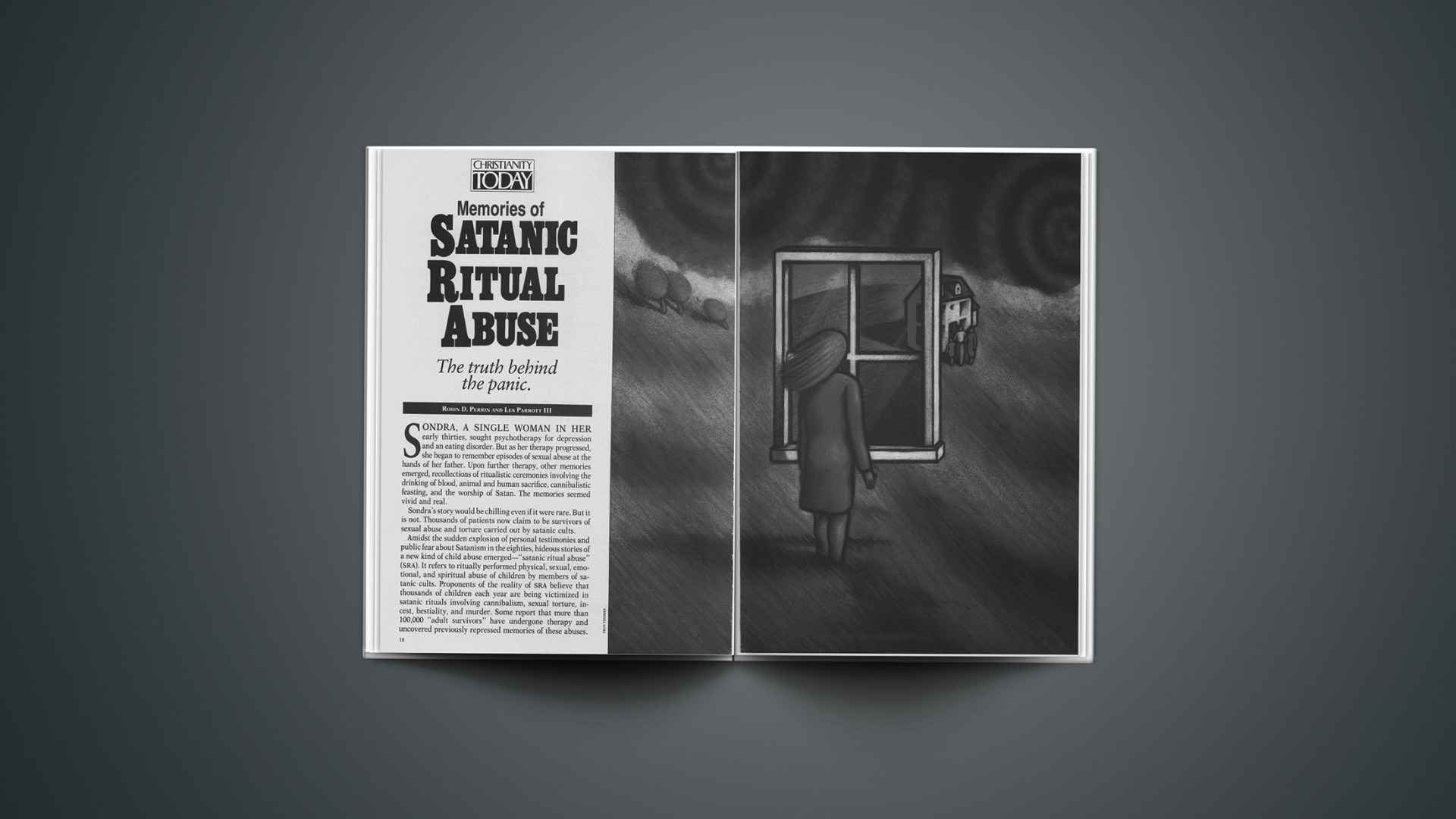The truth behind the panic.
Sondra, a single woman in her early thirties, sought psychotherapy for depression and an eating disorder. But as her therapy progressed, she began to remember episodes of sexual abuse at the hands of her father. Upon further therapy, other memories emerged, recollections of ritualistic ceremonies involving the drinking of blood, animal and human sacrifice, cannibalistic feasting, and the worship of Satan. The memories seemed vivid and real.
Sondra’s story would be chilling even if it were rare. But it is not. Thousands of patients now claim to be survivors of sexual abuse and torture carried out by satanic cults. Amidst the sudden explosion of personal testimonies and public fear about Satanism in the eighties, hideous stories of a new kind of child abuse emerged—” satanic ritual abuse” (SRA). It refers to ritually performed physical, sexual, emotional, and spiritual abuse of children by members of satanic cults. Proponents of the reality of SRA believe that thousands of children each year are being victimized in satanic rituals involving cannibalism, sexual torture, incest, bestiality, and murder. Some report that more than 100,000 “adult survivors” have undergone therapy and uncovered previously repressed memories of these abuses.
The first case of SRA to confront the American public was that of Michelle Smith. Through therapy with her psychiatrist (and later husband), Lawrence Pazder, Smith claimed to discover previously repressed early childhood memories of debilitating physical and sexual abuse by a Satanist cult, which included some members of her family. The two described her therapeutic journey in the book Michelle Remembers (1980). According to Pazder, Smith’s therapeutic experience culminated in an image of the triangular “tip of Satan’s tail” emerging on Smith’s neck. In 1980, Pazder presented a paper at a meeting of the American Psychiatric Association where he coined the term satanic ritual abuse.
Another popular book on satanic ritual abuse was Lauren Stratford’s Satan’s Underground (1988), allegedly a memoir of her involvement and escape from a Satanist cult. Like other SRA survivors, she described black masses, sexualized torture, as well as bearing three children who were sacrificed by the cult. Despite questions about the veracity of her story, Stratford continues to give seminars on the subject and has published two follow-up books.
The therapeutic community is divided over the accuracy of these repressed memories of SRA. The Journal of Psychology and Theology (JPT) devoted its entire Fall 1992 issue to the subject, with articles representing both sides of the debate. In one article, Ruth Shaffer and Louis Cozolino, both affiliated with Pepperdine University’s Graduate School of Education and Psychology, describe a typical therapeutic scenario based on their survey of 20 self-described survivors of SRA: Most survivors do not enter therapy for SRA per se, but for “pre-awareness symptoms of severe depression, anxiety, or dissociation.” The triggers for the SRA memories are usually a contemporary trauma or some “visual or auditory stimuli reminiscent of some aspect of the abuse.” Typically, patients are female and begin therapy around age 27; the therapy lasts an average of seven years, involving several therapists (usually ending with a therapist who believes both in “the reality of the abuse” and “in [the survivors’] capacity to recover”). Repressed memories are rarely exposed all at once. “Many subjects progressed from memories of sexual abuse by acquaintances; to memories of sexual abuse by family members; and, finally, to memories of ritualistic victimization.”
Shaffer and Cozolino note the remarkable consistency of the reports among survivors (even between adult and child victims). “All subjects reported witnessing the sacrificial murder of animals, infants, children, and/or adults.… The vast majority of subjects in this study reported severe and sadistic forms of sexual abuse by multiple perpetrators.” They see the consistency in the reporting as a strong argument in favor of viewing these accounts as accurate.
Another common feature of the professional literature on SRA is a diagnosis of multiple personality disorder (MPD). According to James G. Friesen, a psychologist and adjunct professor at Fuller Graduate School of Psychology, in his popular book Uncovering the Mystery of MPD (1991), children dissociate or split their personality to defend themselves from unrelieved trauma—usually sexual abuse. To complicate matters, Friesen notes in an article in JPT that “demons can disguise themselves as personalities,” especially in cases of SRA. Thus the goals of therapy also include spiritual warfare: “Alternate personalities need to be unified, and evil spirits need to be expelled.”
WHO IS TELLING THE TRUTH?
The testimony of survivors of Satanism provides compelling evidence for its grisly existence. Experts have emerged to uncover Satanism where we never knew to look. And much of their digging has been in the buried memories of SRA survivors. The question is whether the experts uncover Satanism or invent it. Can these accounts be trusted?
One important factor to keep in mind is that we cannot dismiss these stories just because they sound outrageous or unbelievable. It was not too long ago that disturbing stories of sexual abuse and incest were dismissed as fantasies. We did not allow ourselves to believe, for example, that priests or pastors or parents could sexually abuse children. Now these horrors are well-documented facts.
Also, the psychological community has established that adult experiences can trigger repressed traumatic childhood memories to emerge. Freud was the first to refer to this unconscious process of burying painful psychic memories. Critics of the SRA theory, however, maintain that some therapists, in their attempt to help clients recreate horrifying experiences, may do little more than provide an interpretive framework for a person who was abused without a Satanist connection. Childhood memories are by nature often vague and malleable.
Thus we must apply reason and biblical wisdom in determining whether there is a Satanist conspiracy to abuse and murder children. We cannot merely accept at face value accounts provided by self-proclaimed cult survivors, no matter how credible the witnesses may seem.
In Michelle Remembers, for example, Smith and Pazder provide no corroborative evidence for their shocking account. Such evidence is impossible to obtain, they argue, because the cultists “planted” disinformation, such as wrong dates, in Smith’s memory; the Satanist cult is also said to have destroyed the evidence of its crimes. Other experts go so far as to attribute to cults the ability to create particular alternate personalities in victims. According to Cozolino in another JPT article, coauthored with psychologist Catherine Gould, these personalities perform specific functions to protect the cult, such as “reporting information to the cult, self-injuring if the cult injunctions are broken, and disrupting the therapeutic process.” Thus the survivors’ accounts become, as Friesen himself admits, “unverifiable,” since any contingency can be explained away as a cunning tactic by the cult to remain undiscovered.
Still, some accounts have been discredited. After their investigation into the claims made by Lauren Stratford in Satan’s Underground, Christian authors Gretchen Passantino, Bob Passantino, and Jon Trott concluded in Cornerstone magazine that the entire story was a “gruesome fantasy.” Among the more outrageous claims made by Stratford was that she was raped by Satanists and used as a “breeder” of children for Satanist sacrifices. Although Stratford claims to have had three children during her high school and college years, the investigators could not find one witness, nor did Stratford produce a witness. The Passantinos and Trott did find people who knew Stratford during the years she was allegedly pregnant, but all claimed emphatically that she was never pregnant during that time. In fact, no evidence could be found to support her claim that she had been involved with a Satanist cult.
According to the Cornerstone article, Stratford’s story was never independently checked out and confirmed by talk shows on which she appeared, such as “Geraldo,” “The 700 Club,” or even by her publisher. They assumed its truth. After all, who could make up such terrifying experiences? In all fairness it must be said, however, her original publisher eventually did question the decision to publish her story and pulled the book from store shelves.
“What I have written in my books, I have written in the spirit of truth,” says Stratford in a response to these allegations appearing in Bookstore Journal. “If there are any errors, they are errors of memory and not lies.” Stratford’s controversial book has now been rereleased by a new publisher (Pelican), who claims the challenge to the book’s credibility was “a compilation of circumstantial evidence and petty character attacks.”
WHERE IS THE EVIDENCE?
The lack of corroborative evidence cannot be ignored. A seven-year study by the FBI concluded that there is “little or no evidence of organized satanic conspiracies.” FBI agent Kenneth Lanning, for example, confesses, “In 1983 when I first began to hear victims’ stories of bizarre cults and human sacrifice, I tended to believe them. I had been dealing with bizarre, deviant behavior for many years and had long since realized that almost anything is possible. The idea that there are a few cunning, secretive individuals in positions of power somewhere in this country regularly killing a few people as part of some ritual or ceremony and getting away with it is certainly within the realm of possibility.
“But the number of alleged cases began to grow and grow.… We now have hundreds of victims alleging that thousands of offenders are murdering tens of thousands of people, and there is little or no corroborative evidence.”
For nearly a decade, American law enforcement has been aggressively investigating the allegations of victims of ritualistic abuse. So far there is no evidence for the allegations of large-scale baby breeding, human sacrifice, and organized Satanist conspiracies.
As we watched the recent confrontation between federal agents and Branch Davidians in Waco, Texas, we could not help noticing that the press seemingly had little trouble locating defectors willing to provide details of the practices of David Koresh and his followers—this despite the fact that speaking out against Koresh could be dangerous. The availability of ex-Davidians is not necessarily surprising, as previous research has demonstrated that defection rates from deviant religions are quite high. Yet, when it comes to Satanism, a “megacult” supposedly so pervasive and sinister that the Branch Davidians pale in comparison, no one has stepped forward to lead us to an ongoing cult or to the remains of bodies used in human sacrifice, or to any other physical evidence that supports the stories of SRA.
Bob and Gretchen Passantino, who operate Answers in Action, a California-based Christian research organization, are impressed by the secrecy necessary to conceal such a widespread conspiracy. In a broad-based investigative report published in Christian Research Journal, they write, “Let’s suppose there are 100,000 adult survivors [of SRA] who represent only a small subgroup of the conspiracy. They are the ones who were not killed; eventually escaped the cult’s control; got into therapy; ‘remembered’ their abuse; and were then willing to tell others about it.… If we conservatively peg the average number of abusive events per survivor at fifty, that would give us 5,000,000 criminal events over the last fifty years in America alone. And not a shred of corroborative evidence?”
In defending themselves against their critics, advocates of the reality of SRA claim that the similarity of detail in survivor stories proves their accuracy. To assume that this is evidence, however, is to adopt “a naïve and simplistic model of contagion,” according to Frank W. Putnam of the National Institute of Mental Health.
Putnam maintains that the ritualistic-abuse community is especially sensitive to rumors because victims and experts share the same educational networks. Experts on Satanism, talk-show hosts, movie makers, and news shows share the same stories. Given that experts are trained in what to look for, it is no wonder that survivor accounts are markedly similar, as were the internal communist revelations during the McCarthy era. The same could be said of the evidence for UFOs. Hundreds of people who claim to have been abducted by aliens give remarkably similar descriptions of the space ships and aliens.
IS OUR DEVIL TOO BIG?
In order to fully understand SRA, we must realize how our culture has responded in the past to stories regarding the activity of Satanists. No matter how thin the evidence for Satanist stories, there seems to be a bias to believe them.
One example is the widely circulated story that an executive of Procter and Gamble (P&G) appeared on a popular talk show (usually said to be “Donahue”) and admitted he was a devil worshiper, and that much of P&G’s profits went to the Church of Satan. Often the information is passed along as a flier giving the date of the broadcast, an address for how to write for a copy of the transcript of the telecast, and instructions to boycott Crest toothpaste, Ivory soap, and other P&G products. The details make the story seem more than rumor.
But it is all a lie. No one from P&G has ever appeared on “Donahue,” and the company has no connections with the Church of Satan. Still, the pressure has been such that P&G felt compelled to remove its man-in-the-moon trademark from its products since some saw it as occult and thus confirmation of the company’s link with Satanism. Regarding the “Donahue” story, Ann Jenemann Smith, public-relations supervisor at P&G, says, “The rumor just won’t die.… We have publicized letters of support from Billy Graham, Jerry Falwell, and others to squelch the rumor, and we still average more than 20 calls every day about it.”
Recently a similar rumor has been circulating, involving clothing designer Liz Claiborne’s appearance on “Oprah” where she allegedly announced herself to be a Satanist. Inquiries to the show regarding a transcript are returned with a mass-produced postcard stating, in a tone that could best be described as annoyed, that Liz Claiborne has never appeared on “Oprah” or any other afternoon talk show.
Satanist conspiracy theories are not exclusive to major corporations. Numerous heinous crimes have been attributed to devil worshipers. For instance, a gruesome murder of a 39-year-old woman in Missoula, Montana, set off a chain of rumors that linked her death to a Satanist cult that was initiating a “high priesthood of Satan.” Stories were told of animal mutilations, infant sacrifices, witches chanting in the woods, and satanic plots. In one report, the police received a hysterical call from a woman who claimed her neighbor was a member of the cult who killed the victim. She was sure it was true because he had been “sacrificing dogs.” On investigation, the police learned the accused neighbor was a hunter who had hung several animal skins over his back fence to dry. Although the bizarre tales of satanic activity related to the murdered woman eventually ran their course, they made a lasting impact on many people in Missoula. The murder was later solved, and police found no evidence whatsoever that any Satanist cult was involved. Still, the local folklore is steeped in witchcraft, and the rumors live on in the minds of people with a will to believe.
In another example, a number of cattle mutilations, hundreds of miles apart in the plains states, were rumored to be the work of devil worshipers. The missing parts from some cattle were said to have been removed with “surgical precision.” In some cases, the blood appeared to have been drained from the carcasses. Speculation about the perpetrators ran the gamut from UFOs to Bigfoot. But the most common story attributed the mutilations to Satanists. Official investigations, however, revealed that the gory deaths were the result of animal predators, such as coyotes.
The crescendo of reports on Satanism in Los Angeles led the city to create the Ritual Abuse Task Force. The task force, which has been controversial since its inception in 1988, recently received front-page headlines when several of its members charged Satanists with attempting to silence them by pumping the pesticide diazinon into the air-conditioning vents of their offices, homes, and cars. Despite the fact that diazinon poisoning is easy to detect, according to the epidemiologist assigned to the case, none of the 43 supposed victims of the poisoning could provide any evidence.
WHO IS BEHIND THE PANIC?
These false reports and Rumors should not lead us to conclude that there is no such thing as Satanism in America. In fact, some people can be identified as Satanists. Furthermore, it is a fact that crimes that were committed as part of Satanist rituals, usually involving the mutilation of small animals, have been reported in the media.
Contemporary American Satanism can be traced to the late 1960s. The most celebrated Satanist church to emerge from the decade was ex-carnival worker Anton LaVey’s Church of Satan in San Francisco. While the Church of Satan has never been numerically significant (current estimates range from 2,000 to 5,000 active members), LaVey’s church has attracted considerable media attention—especially his Satanist baptisms and weddings. LaVey has made a point of being offensive in ways that have made news and brought him undeserved attention. Other Satanist churches include the Process, the Solar Lodge, and the Temple of Set, but they, too, have attracted few followers. Still, in LaVey’s own The Satanic Bible, he claims that “Satanism does not advocate rape, child molesting, sexual defilement of animals,” and no organized Satanist church has ever been linked with practices associated with SRA.
Part of the blame for the obsession with Satanism must lie with the media. While the “prestige press,” such as network news programs and national newspapers, has avoided explorations of Satanism as hard news, more sensational shows like “Donahue” and “Geraldo” have had a field day. With a broadcast every weekday, such shows require up to 250 riveting topics each year. For TV producers, the primary concern is ratings. And when it comes to Satanism, people do watch. In 1988, a two-hour, prime-time Geraldo Rivera special, “Exposing Satan’s Underground,” set record ratings of nearly 20 million people—the largest audience ever for an NBC documentary. The drudgery involved in checking facts works against the shows’ goals of ratings and profits.
But TV is not the only culprit. One of the most celebrated “survivors” of Satanism is Mike Warnke. His book The Satan Seller was released in 1973 and promoted as revealing “the demonic forces behind the fastest growing and most deadly occult religion in the world.” The book has reportedly sold 3 million copies. And for two decades, it has been cited by people inside and outside the Christian community to prove the existence of a large-scale Satanist conspiracy—that is, until recently. The self-professed ex-Satanist has been charged with fabricating his life story as a Satanist high priest (CT, Aug. 17, 1992, p. 50). Significant evidence contradicting his alleged Satanist activity was revealed by Jon Trott and Mike Hertenstein in an article in Cornerstone magazine. College friends of Warnke’s say his story of being a Satanist high priest does not line up with the life of their former buddy. Warnke has admitted to fabricating some details and to exaggerating, but he has thus far stuck to the rest of his story without countering any of the specific charges.
These and other stories have had an effect on what America thinks about this issue. A 1989 survey conducted by the Public Policy Laboratory of Texas A & M University reported that 80 percent of Texans believe Satanism is getting worse, and that it is something to worry about. Another study presented at the 1990 annual meeting of the Society for the Scientific Study of Religion revealed that more than 70 percent of today’s churchgoers agree that Satanism is spreading rapidly, that it is becoming increasingly organized, and that it is a serious threat to society. Given this context, people have little trouble believing in an organized Satanist conspiracy to sacrifice and torture children.
WHY IS IT HAPPENING?
If we are accurate in our skepticism of the extent of SRA, and of the Satanist scare generally, one very important question remains yet unanswered: How can so many well-meaning counselors, pastors, and individuals be wrong?
The answer begins with the recognition that counselors today, understanding that victim disclosures have historically been met with disbelief, are taught to listen to and accept victim accounts of abuse. More than at any time in human history, counselors are acutely aware of the symptoms, prevalence, and consequences of child physical and sexual abuse. Add to this sensitivity a societal fascination with Satanism, and distortions are bound to occur. In an interview on ABC’s “Prime Time Live,” Cory Hammond, a staff psychologist at the University of Utah Hospital and the “guru of SRA,” stated, “Therapists shouldn’t be responsible for providing evidence [of SRA].”
One explanation is that the concept of Satanism may provide a ready explanatory grid for people trying to discover the source of their psychological problems. In a workshop entitled, “Errors in the Diagnosis and Treatment of MPD and SRA,” psychologist Dane Ver Merris, of Pine Rest Christian Hospital in Grand Rapids, told the International Congress on Christian Counseling in Atlanta that many supposed survivors of SRA have psychological problems making them more susceptible to suggestions of having been ritualistically abused by Satanists.
It does not take much for imaginative individuals who have been abused to “recall” and believe that their abuse is directly connected to Satan. In coping with crisis, people tend to divide the world into simple categories—good and bad. In trying to understand confusing and horrific circumstances, any explanation can seem better than no explanation. After reading a book, viewing a show, or hearing a sermon, victims may discover a new hook on which to hang their traumatic experience. To objectify the cause of their pain can be an emotional release. This reasoning may explain, at least in part, the recent increase in victims who have “remembered” their satanic abuse. According to a report in Charisma magazine, even Lawrence Pazder, the psychiatrist who coined the term satanic ritual abuse, now sees SRA memories as more an expression of a deep level of violation caused by abusive family members than actual accounts of SRA.
HOW DO WE RESPOND?
No one wants to minimize the trauma and terror victims suffer at the nefarious hands of Satanists or anyone else. No one wants to revictimize courageous survivors by not believing their horrific stories. Depraved people do evil things. And some people do perform gruesome acts of abuse, even acts that could be called ritualistic abuse.
Physical and sexual abuse, involving cultic activity or not, is plainly evil and influenced by Satan—whether or not it is done in his name. An individual’s satanic abuse, real or imagined, should be taken seriously. The victim’s pain and trauma is real and needs healing. We are called to shepherd the sheep, not shear them.
Still, we must avoid the danger Paul warns about in 2 Corinthians: “I am afraid that as the serpent deceived Eve by his cunning, your thoughts will be led astray from a sincere and pure devotion to Christ” (11:3). We have an obligation to listen to our Christian brothers and sisters, but we also have a scriptural obligation to evaluate what they say. We cannot fall victim to sloppy thinking or judgment based on a mixture of fallacies, nonevidence, and subjectivism.” He who chases fantasies lacks judgment” (Prov. 12:11). We must rely on careful Bible study, prayer, worship, and the fellowship and wisdom of other believers while we retain our commitment to compassion for the victims.
Some will argue that a reluctance to believe these accounts and a demand for evidence plays into the hands of Satan. They will argue that the Bible teaches us that Satan’s influence is secretive and elusive. On this point, we agree (though one of the Devil’s primary tools is confusion, and with that tactic he has been very much involved in the debate over SRA). Yet the burden of proof for disturbing stories of Satan’s influence must lie with those who are making the claims. Extraordinary claims require evidence, and mere plausibility is not evidence.
Christians are by no means solely responsible for the Satanism scare. At the same time, we seem to have been especially willing to accept and spread the rumors. Christian author Jon Trott claims that when one looks at the “wads of Christian literature, tape, and airtime dedicated to alleged satanic cults, it is easy to conclude we’ve asked for it.” We seem to have the will to believe and suffer little ethical pressure when we repeat rumors that may not be true. “There are a thousand hacking at the branches of evil,” said Thoreau, “to one who is striking at the root.”
Loren Wilkinson is the writer/editor of Earthkeeping in the ’90s (Eerdmans) and the coauthor, with his wife, Mary Ruth Wilkinson, of Caring for Creation in Your Own Backyard (Servant). He teaches at Regent College in Vancouver, British Columbia, Canada.










